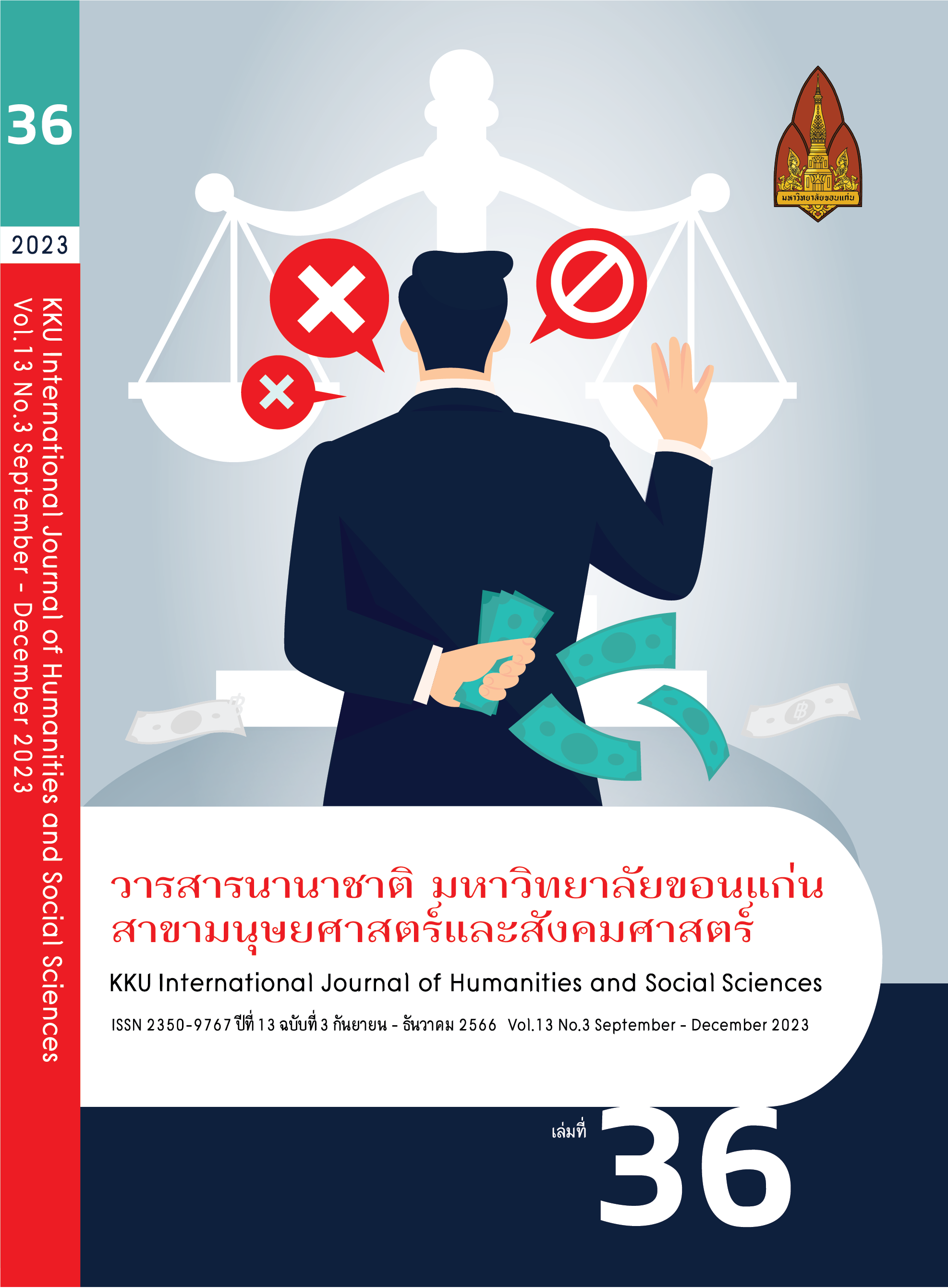Assessment of Farmer Knowledge and Practices towards Rice GAP Standard in Namxouang Irrigation Development Area, Vientiane Capital, Lao PDR
Main Article Content
Abstract
The objectives of the study aims to discover socio-economic background, assess knowledge and practices, and factors affecting farmers’ knowledge and practice on Good Agriculture Practices (GAP). The survey includes 70 samples in Namxouang irrigation development area, Vientiane Capital, Lao PDR. Interviews were used for data collection. Both descriptive and inferential statistics were applied to analyze farmer knowledge, practices, and factors influencing farmer knowledge and practices towards rice GAP standards. The findings revealed that the overall average of farmer knowledge and practices related to rice GAP were 0.54 and 0.45, respectively, meaning that their knowledge was at a moderate level and their practices were moderate. On the other hand, gender, experience, annual income, and amount of credit had a significantly positive influence on farmer knowledge towards rice GAP standards; while media perception and amount of credits had significantly influenced farmer practices towards rice GAP. In conclusion, training courses are required to increase farmer knowledge and practices on rice production at GAP standards, to help them improve rice quality and productivity in the study area.
Article Details
References
Abubakar, H.N., Garba, Y., Gana, A.K., and Jocob, I.A. (2019). Factors Influencing Adoption of Rice Improved Production Practices by
Farmers in Adopted Villages, Niger State, Nigeria. Advances in Plants and Agriculture Research, 9 (1): 183 – 189. https://medcraveonline.
com/APAR/APAR-09-00433.pdf
Arkin, H. (1974). Handbook of Sampling for Auditing and Accounting. McGraw-Hill Company, USA.
Ayenew, B.K, and Tilahun, A.A. (2022). Factors Influencing the Adoption of Climate-Smart Agricultural Practice by Small-Scale farming Households in Wondo Genet, Southern Ethiopia. SAGE Open: 1-13. https://doi.org/10.1177/21582440221121604
Bourjac, M., Ferrand, P., and Castella, C. (2017). Sustainable Intensification of Rain Fed Lowland Rice Systems: A Case Study in Xiengkhouang Province in Lao PDR. Asia Notes 34 – Special Issue. Retrive: https://agritrop.cirad.fr/586378/1/2017_Bourjac_Sustainable%20intensification%20of%20rainfed%20lowland%20rice%20systems.pdf
DAFO. 2018. The Report on Implemented Work and Agricultural and Forestry Development Plan for 2017-2018. Naxaythong District Agricultural and Forestry Office, Vientiane Capital, Laos.
FAO. (2020). GIEWS Country Brief: The Lao People’s Democratic Republic. Retrived May 20, 2022, from https://reliefweb.int/attachments/338c66d0-5e7b-3324-be87-6797dbd0d84a/LAO.pdf
Huyly, T., Kasem, S., Chaiwat, M., Aram, A. (2011). Comparison between Organic, GAP and Chemical Methods for Cultivation of Rice Varities in Cambodia. Journal of Agricultural Technology, 7(5), 1435-1441. http://www.ijat-aatsea.com/pdf/September_v7_n5_11/28_IJAT2011_7_5_%20Huyly_ F.pdf
Islam, R. (2018). Sample Size and Its Role in Central Limited Theorem (CLT). Computational and Applied Mathematics Journal. 4(1), 1-7. https://www.researchgate.net/publication/325574161
Kuder, G. F. and M. W. Richardson. (1937). The theory of the estimation of test reliability. Psychometrika, 2: 151–160. https://doi.org/10.1007/BF02288391
Liese, B., Isvilanonda, S., Tri, K. N., Ngoc, L. N., Pananurak, P., Pech, R., Shwe, T. M., Sombounkhanh, K., Mollmann, T., & Zimmer, Y. (2014). Economic of Southeast Asian Rice Production. Rome, Italy: Food and Agriculture Organization.
LSB (Lao Statistics Bureau). 2021. Statistical Year Book 2021. Vientiane, Lao PDR: Lao Statistics Bureau, Ministry of Planning and Investment.
Ministry of Agriculture and Forestry (MAF). (2010a). Strategy for Agriculture Development 2011 to 2020. Department of Planing and Investment, Ministry of Agriculture and Forestry, Vientiane, Lao PDR.
MAF. (2010b). Agricultural Master Plan 2011 to 2015. Department of Planing and Investment, Ministry of Agriculture and Forestry, Vientiane, Lao PDR.
MAF. (2012). System of Rice Intensification: Guideline on SRI practice in Irrigated Paddy Fields in Laos. Northern Rural Infrasrtructure
Development Sector Project, Ministry of Agriculture and Forestry, Vientiane, Lao PDR.
MAF. (2015). Agriculture Development Strategy to 2025 and Vision to the year 2030. Ministry of Agriculture and Forestry, Vientiane Capital, Lao PDR.
MAF. (2021). Green and Sustainable Agriculture Framework for Lao PDR to 2030. Department of Policy and Legal Affairs, Ministry of Agriculture and Forestry, Vientaine, Lao PDR.
Mekong Institute (MI). (2017). Mekong Connection. The Newsletter of Mekong Institute. Khon Kaen, Thailand.
Ministry of Planning and Investment (MPI). (2016). 8th Five-Year National Socio-Economic Dvelopment Plan (2016-2020). Ministry of Planning and Investment, Vientinae, Laos.
MPI. (2021). 9th Five-Year National Socio-Economic Dvelopment Plan (2021-2025). Ministry of Planning and Investment, Vientinae, Laos.
Mushobozi, L. W. (2010). Good Agricultural Practices (GAP) on Horticultural Production for Extension Staff in Tanzania, Training Manual. Rome, Italy: FOA GAP Working Paper Series No.13. Food and Agriculture Organization of the United Nations. http://hdl.handle.net/20.500.12018/7137
Newby, J., Manivong, V., & Cramb, R. (2013). Intensification of Lowland Rice-Based Farming Systems in Laos in the Context of Diversified Rural Livelihoods. Paper presented at 57th Annual Conference on Australian Agricultural and Resource Economics Society (AARES) 2013, Sydney,Australia.
Pandey, S. (2001). Economics of Lowland Rice Production in Laos: Opportunities and Challenges. In S. Fukai and J. Basnayake. (eds.).
Increased Lowland Rice Production in the Mekong Region. (p. 20-30). ACIAR Proceedings 101, Australian Centre for International Agricultural Research (ACIAR).
Phranakhone, P and Nanseki, T. (2015). Study on Profitability and Factors Influencing participation in Organic Farmer Association: A case Study of Sangthong District, Vientiane Capital, Laos. J. Fac. Agr., Kyushu Univ.,60: 259-264. https://doi.org/10.5109/1526318
Rapankum, N., Hanmontree, R., Srilapat, C., Niljinda, K., and Chaisombut, P. (2022). Factors Affecting the Acceptance of Dairy Farming Standards by Modernized farmers for Agricultural Extension in Thailand. Asian Journal of Agriculture and Rural Development, 12(4): 243 - 249. https://doi.org/10.55493/5005.v12i4.4641
Sacklokham, S. (2014). Rice-Based Farming Systems in Lao PDR: Opportunities and Challanges for Food Security. Vientiane Capital, Lao PDR: Faculty of Agriculture, National University of Laos.
Senthilkumar, K., Tesha, B., Mghase, J. and Rodenburg. (2018). Increasing Paddy Yield and Improving Farm Management: Result from Participatory Experiments with Good Agricultural Practices (GAP) in Tanzania. Paddy and Water Environment, 16: 749-766. https://doi.org/10.1007/s10333-018-0666-7
Sourideth, V., P. Ouanesamone, and J. Newby. (2011). Factors Influencing the Adoption of Corn in Irrigated Rice-Based Farming Systems in Lao PDR. Australia: NAFRI, MAF, Lao PDR and the University of Queensland, School of Agriculture and Food Sciences.
Tubvongsa, K. (2022). Study on the Factors Influencing the Adoption of Good Agriculture Practices Standard in Rainfed Rice Cultivation Technology in Vientiane Capital. (Master Thesis) Faculty of Agriculture, National University of Laos.
Wailes, J. E. & Chavez, C. E. (2012). ASEAN and Global Rice Situation and Outlook. Manila, Philippines: ADB Sustainable Development Working Paper Series. https://www.adb.org/sites/default/files/ publication/29969/adb-wp-22-asean-global-rice-situation.pdf


